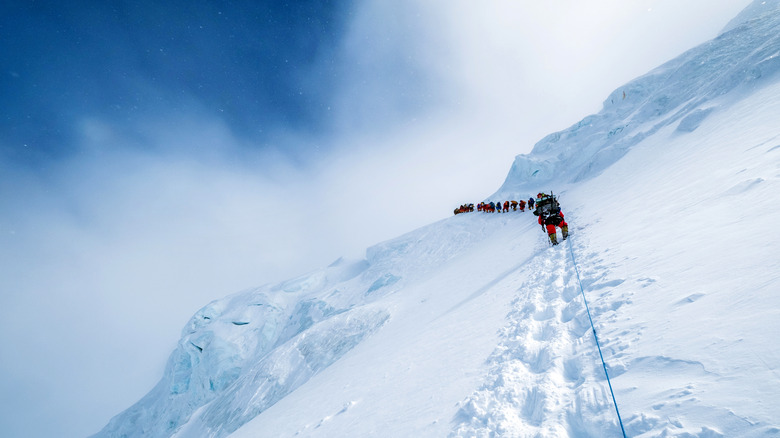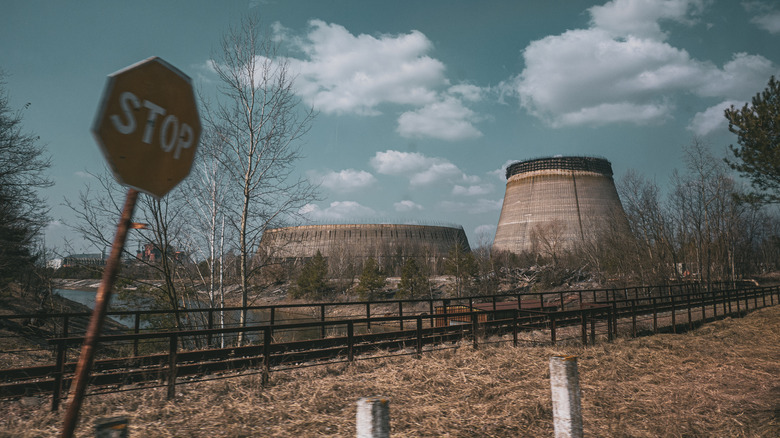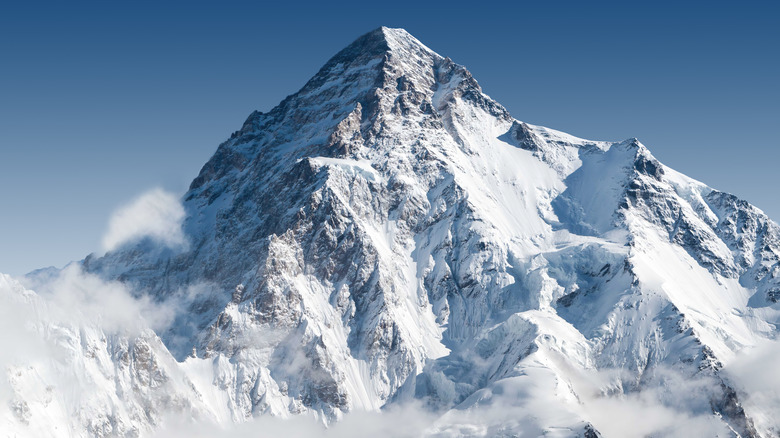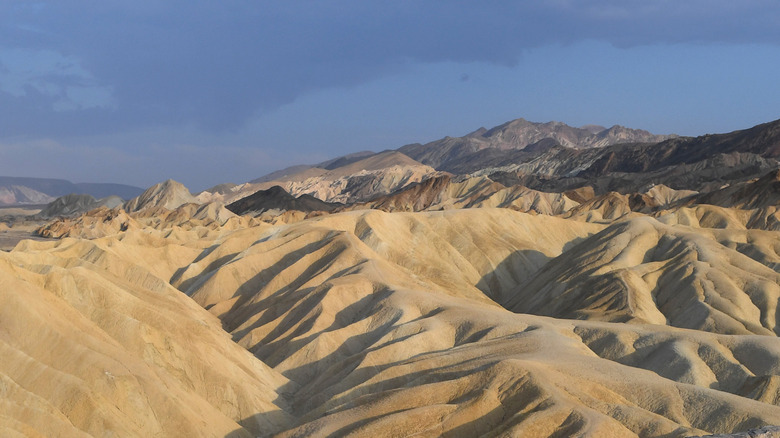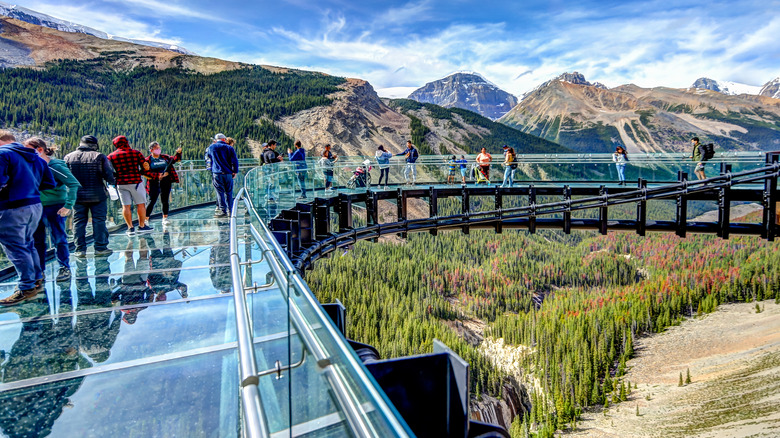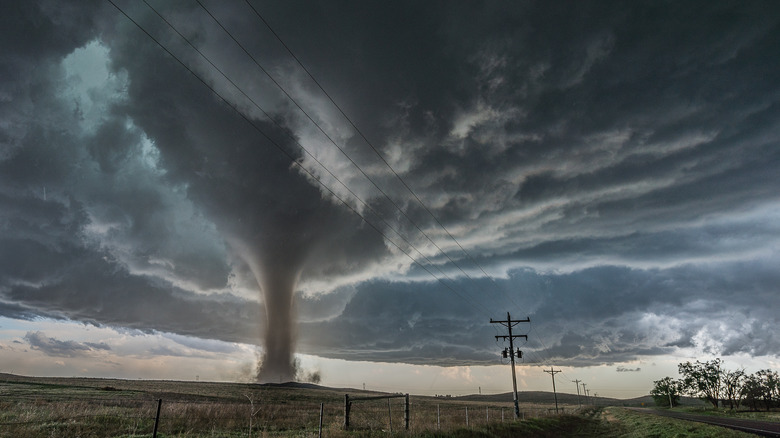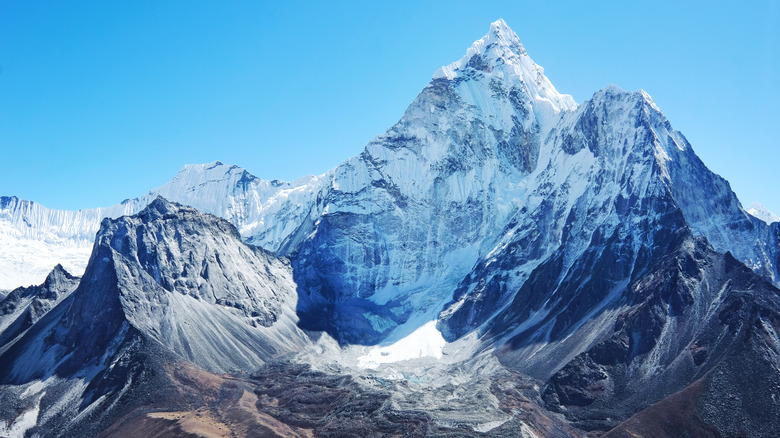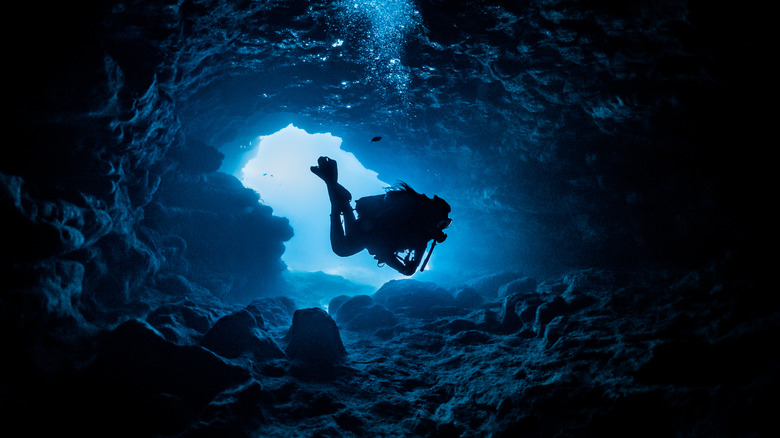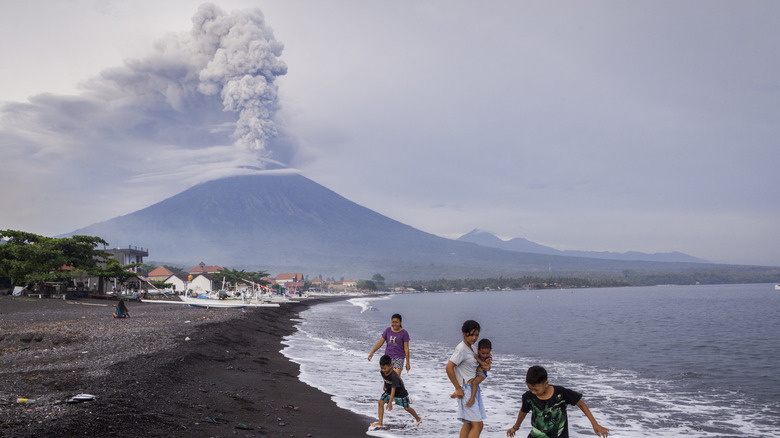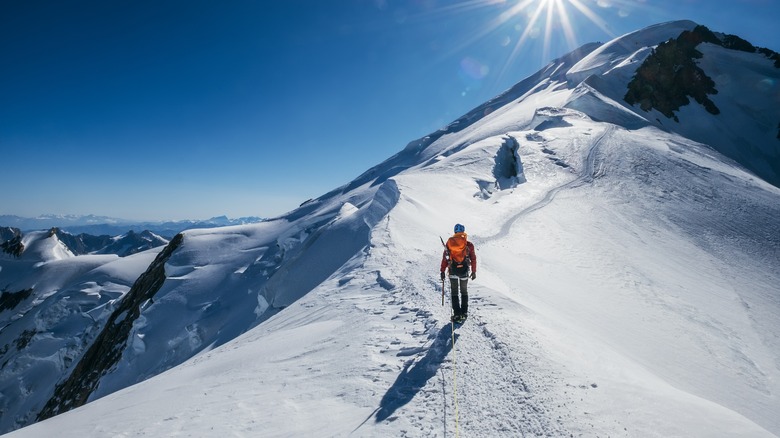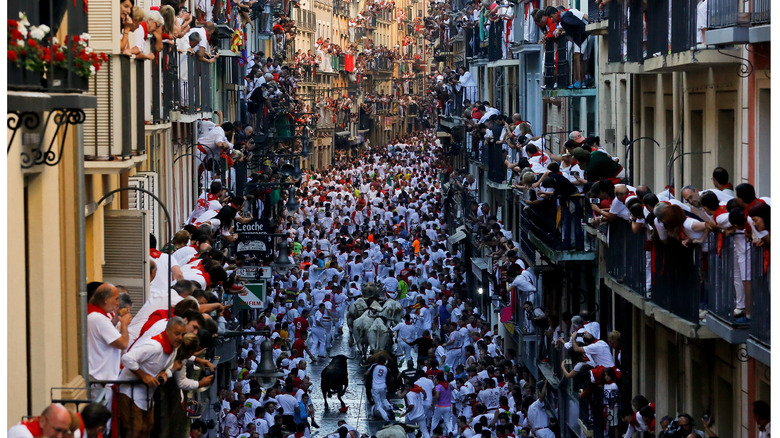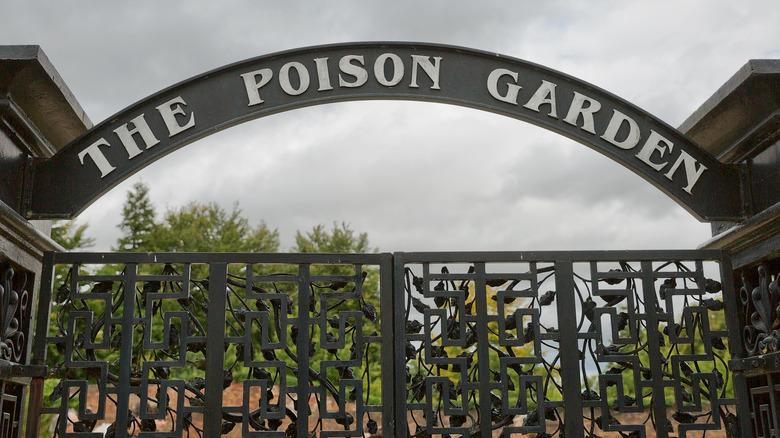The Most Dangerous Tourist Attractions In The World
While many spend their lives trying to avoid danger and tragedy, millions of people travel around the world to spend their vacations in some of the most perilous places on the planet — and pay for the privilege.
"Adventure tourism," refers to traveling to exciting destinations to participate in difficult or risky activities — usually outdoors — and experience something that you couldn't do at home. As described in R. Buckley's book, adventure tourism is sometimes about the activity and sometimes about the location. Often, it's both. Famous feats, like climbing Mount Everest, have become increasingly popular — to the point of overcrowding. Other destinations, like North Korea, are only available to a small number of people and are strictly controlled. Some spots are only destinations for tourists with specific hobbies and specialized skills, like deep sea caves or the sites of potential storms.
While this type of tourism can be thrilling, it can also be deadly. Some attractions require immense preparation and training to attempt, which some tourists may not be aware of before they arrive. Others are inherently risky, violent, or unpredictable, and can pose a genuine threat to any who attempt to visit. These are the most dangerous tourist attractions in the world.
Nuclear tourism
The sites of some of humanity's most horrific nuclear tragedies have become tourist hotspots. Companies offering tours have sprung up around locations like Chernobyl — but visitors may not be safe from radiation.
As described by the New York Times, Chernobyl was once the site of the worst nuclear disaster in history. Today, portions of it have returned to nature. In the 30 years it has been abandoned, the remains of human homes have become overgrown. Entering these abandoned buildings is dangerous, not due to radiation but because of the threat of collapse.
Journeys into the Chernobyl Exclusion Zone have become popular, not in spite of the suffering that occurred there, but because of it. The Washington Post credits the rise in tourism to Chernobyl to the video game "S.T.A.L.K.E.R.," a first-person shooter set at Chernobyl, and the HBO miniseries "Chernobyl" which depicted the events surrounding the disaster. Since the airing, various companies offering guided tours of the Exclusion Zone have reported 30-40% increases in tourists.
Radiation is still a threat at Chernobyl, but the amount of exposure depends on where in the Exclusion Zone tourists go, and how long they stay. The forest around Chernobyl was not part of the cleanup, and the plant life there is radioactive. Tourists are advised to spend as little time there as possible, wear a mask and gloves, and throw away the clothes they wore.
K2
There are always risks when it comes to the extreme sport of mountaineering, but not all mountains are equal. The Pakistani mountain K2 is the second tallest, second only to Mount Everest. As reported by National Geographic, Everest may be taller, but K2 is considered the most difficult mountain to climb.
Less than 400 people have ever successfully reached the top of K2. While K2 is called by its alphanumeric designation that it was given during a 19th-century surveying project, it has come to be known as "Savage Mountain." As described by NASA, this nickname comes from the extreme risk to climbers due to frequent avalanches and extreme weather conditions. Only one mountaineering team has summited In winter, when it can reach a low of -58°F, and in 2012, the mountain was believed to have a fatality rate of 29%.
The trip to K2 can also prove hazardous for tourists. In February of 2022, the U.S. government recommended that Americans "reconsider travel to Pakistan due to terrorism and sectarian violence."
Death Valley
Death Valley National Park receives approximately 1 million tourists every year. As described in "Death Valley," tourists have been visiting Death Valley since there were roads to get there. In the 1920s, the first resort was built to accommodate the many visitors. But the extreme conditions that make it enticing to tourists can also put them at risk.
The extreme conditions there have given rise to a variety of ominous names beyond "Death Valley," including "Coffin Canyon," "Chaos Ridge," and "Dripping Blood Cliffs." It is one of the hottest and driest places on the planet. In 1913, Death Valley was 134°F – the hottest temperature ever recorded. In 2001, the temperature was over 100°F for 154 days straight. There have been a number of fatalities in Death Valley because of the extreme heat. Because of this, the NPS encourages tourists visiting Death Valley in the summer not to hike after 10 a.m., stay in the mountains, and always pack items necessary for survival in case of emergency.
According to the NPS, there are concerns beyond the high temperatures. As is expected for a national park, many creatures make their home there, and some can be dangerous to humans, including scorpions, rattlesnakes, and poisonous spiders. Flash flooding may occur in the canyons during storms. There have even been illegal pot fields found within the park. If visitors stumble into them, they are advised to "run, walk, crawl or hide" and leave as quickly and quietly as possible.
Skywalks
Glass bridges, walkways, and slides have become popular around the world, but especially in China. There are around 2,300 glass bridges in China alone. They have become a part of many tourist attractions because they blend in and don't detract from the attraction itself. As described by The New York Times, the longest is more than 1,700 feet, and stretches across a gorge 650 feet below. For some, the dizzying appearance of being able to see the ground far below is part of the appeal. One was designed to sway, while another looks and sounds like it is cracking when it is walked on. Unfortunately, sometimes these walkways genuinely break, with devastating consequences.
As reported by the BBC, in 2021, a tourist was left hanging onto the side of a bridge after the glass bottom broke. He was ultimately rescued by the fire department, but not all visitors have survived. In 2019, one tourist was killed and others were injured falling off of a glass slide.
While skywalks are extremely popular in China, the tourist attractions in the United States have also had to rethink them for safety reasons. The Grand Canyon has a horseshoe-shaped skywalk, which had to be re-evaluated for safety after a death in 2019.
Storm chasing
Storm chasing is exactly what it sounds like: following potential storms for a chance to see incredible storms in action. As described by The Washington Post, it requires years of experience and a thorough understanding of weather. Chasers try to predict how storms, especially tornadoes, will develop so that they can witness them at their strongest. They have to be close enough to see the storm, but far enough away that they aren't in danger.
As described in "When Severe Weather Becomes a Tourist Attraction: Understanding the Relationship with Nature in Storm-Chasing Tourism," some tourism companies charge for tours which promise the chance to witness incredible storms, but cannot guarantee that the storms will happen. Storm chasing requires predicting the weather — something which is extremely difficult. The morning of the storm, chasers have to look at multiple weather models and create a forecast that they believe the storm will follow, and get into position. Often, even experienced chasers guess wrong and miss the chance to see a storm they've been tracking for days.
While missing the storm is the most likely result of a miscalculation, it is possible to end up in the storm's path instead. As explained by storm chaser and meteorologist Charles Doswell (via USA Today) there are extreme chasers who are willing to do "virtually anything" to see a storm in action. It can even be dangerous for experienced chasers. In 2013, three veteran chasers died attempting to see a devastating mile-wide tornado.
Mount Everest
Mount Everest is renowned as the tallest mountain on land, and climbing it has become a bucket list item for many. Even though some of those people have never climbed a mountain before. Everest has become a tourist hotspot and as reported by NPR, hundreds of people climb the mountain every year — paying around $11,000 each for the privilege. While summiting this mountain is a dream for many, climbers die in the attempt every year.
A climber who summitted Everest in 2019 told The New York Times that when he reached the top, he found 15-20 people on the tiny area at the top of the mountain. He witnessed climbers shoving each other and jostling for the best positions to take photos. At one point, he had to step over the body of one of his fellow climbers who had died on the mountain.
Tourism companies are encouraging more climbers to come, even ones who have no experience. Nepal, one of the nations with access to Everest, relies on the money coming in from tourism, so they do not limit the number of climbers. This leads to situations with severe overcrowding. Sometimes climbers have to wait for hours in long lines while in areas with very little oxygen while depleting their personal supply. An investigation into the practices on Everest found that some of those oxygen systems were faulty in the first place and could leak or even explode, leaving the climbers without air.
Underwater cave diving
Divers descend into underwater cave systems to explore, study, and experience their mysterious depths. As described by National Geographic, Florida's Eagle's Nest Sinkhole looks like an ordinary pond from above, but below is a complex cave system with maze-like twists and turns, fascinating geological features, and translucent marine life — but it is also among the most dangerous dives in the world. More than 10 divers, some with training, have died at Eagle's Nest.
Research has shown that the number of cave diving accidents leading to deaths has decreased over time, but it is still a risky endeavor, especially without proper training. A study of cave diving fatalities found that the majority of deaths were drownings, caused by running out of cylinders of gas. Eagle's Nest is extremely deep and maze-like, which increases the risk.
Still, the journey down from the surface is an incredible one. First, the diver passes through a limestone tube and enters a massive open space. Deeper, divers can find a place known as the "Super Room" where the walls are banded in blue, white, and gray. There are creatures that live their entire lives in the cave, including a species of translucent crayfish. According to cave diving expert Jill Heinerth (via National Geographic) these creatures can live 200 years in the darkness of the caves. Scientists study the unique habitats found in underwater caves for clues about what life may be like on other planets.
Volcano tourism
Millions of tourists travel around the world every year to see one of nature's most striking features — volcanoes. As detailed in "Fiery eruptions: travel health risks of volcano tourism," these trips can be unpredictable and dangerous.
There are three different designations that a volcano can have, determining its position in its "lifecycle." There are active volcanoes, or ones that erupt regularly. There are dormant volcanoes, which have not erupted for a very long time, but may erupt again someday. There are extinct volcanoes that haven't erupted in all of human history. While it would seem logical that people would avoid those that aren't dormant or extinct, many of the most popular ones are active, such as Mount Agung in Bali, Mount Etna in Sicily, and Eyjafjallajökull and Katla in Iceland.
While many eruptions are predicted, some occur with no warning at all. This means tourists may be visiting a volcano when it erupts. They risk burns from currents of hot gas and debris and exposure to toxic gas. As reported by National Geographic, avalanches are also a risk. Mount Shirane in Japan erupted and triggered an avalanche which killed one person and injured several others.
Mont Blanc
Mont Blanc is the tallest peak in the Swiss Alps, but it isn't the most difficult to climb. The majority can be walked (though some parts do require climbing equipment like ice axes). Despite this, around 100 climbers are killed there every year — far more than K2 or Everest. The main causes of death are slipping, being struck by a falling rock, or getting lost in bad weather.
As described in The Atlantic, one reason for the incredibly high number of deaths is actually because it's easier than other mountains. Tourism companies promote climbing Mont Blanc as extremely easy, and doable for people who have never climbed a mountain before. 84% of people who required emergency medical attention on the mountain were amateurs.
As stated by the New York Times, more than 20,000 people try to climb Mont Blanc every year. The way up the mountain that the majority of climbers use has steep steps, falling rocks, and a narrow ridge which is only a few feet across. The mountain is overcrowded, which makes the climb more dangerous. Some groups are forced to wait while other climbers use narrow areas, increasing the dangers of the cold, weather, and high-altitude. The alternative is for groups to pass one another in narrow spots, increasing the risk of falling. It is only becoming more dangerous as the climate crisis gets worse. The routes up the mountain have become steeper and more slippery, and falling rocks are more common than ever.
Running of the Bulls
The Running of the Bulls is an internationally famous tradition (made even more well-known by Ernest Hemmingway's "The Sun Also Rises" in 1926). Every year it attracts thousands of tourists to Pamplona to watch, or even participate in, the bloody spectacle.
Bull runs take place all over the world, but none are as famous as the massive Running of the Bulls in Pamplona. As described by Time, the festival was originally a religious event honoring a martyred bishop. The Running of the Bulls is believed to have started in the 13th century, as nothing more than a way of getting bulls into position. Over time, it became known as a way for average citizens to prove bravery. Every summer, 12 bulls (or, more accurately, six bulls and six mostly harmless steers) are released from a pen and herded down narrow cobblestone streets into bullfighting rings, where they are typically all killed. A "running course" is used to ensure the bulls cannot escape.
Participants run through the streets ahead of the bulls. As reported by The Guardian, participants are sometimes gored or trampled by the terrified animals. Occasionally, an onlooker is also killed.
The Poison Garden
The Alnwick Garden is an extremely popular attraction, boasting more than 600,000 tourists every year. Visually, it is an inviting garden full of beautiful flowers. The Alnwick Garden is more than pretty, however. It can be deadly. As detailed by Smithsonian, every plant in the garden is poisonous. "I thought, 'This is a way to interest children,'" Duchess Jane Percy explained. "Children don't care that aspirin comes from a bark of a tree. What's really interesting is to know how a plant kills you ... and what you feel like before you die."
The garden is located at Alnwick Castle. In 1995, it was inherited by a new Duke of Northumberland. He encouraged his wife, Jane Percy, to take over the gardens (which were at the time used only for growing Christmas trees). Percy had another idea. She sought out an acclaimed landscape architect, Jacques Wirtz, to design a new deadly garden.
The garden is under constant surveillance because of the plants that grow there. As described in Atlas Obscura, some plants are kept in cages. Even with all the precautions at the garden, visitors occasionally feel faint from the fumes.There are 100 varieties of plants, most of which are deadly, as well as plants associated with drugs such as hallucinogenic mushrooms and opium poppies. Visitors can go on educational tours and even picnic in the Alnwick Garden, but they are warned never to touch or smell the plants.
North Korea
In 2015, 21-year-old Otto Warmbier went on what was supposed to be a three-day tour of North Korea. According to a propaganda video (reported on by the BBC), Warmbier tried to take a sign from his hotel home with him. He was held in captivity for 17 months, was returned to the United States in a coma, and ultimately died. What exactly happened to him is still unknown. The United States government advises people not to visit North Korea, due to "the serious risk of arrest and long-term detention."
Despite this, it is possible for some tourists to visit every year. As described by CNN, the trips are very strictly controlled. Visitors are not allowed to actually explore the country; instead, guides from North Korea's Ministry of Tourism take tourists to specific approved spots. Tourism companies based in China fly tourists to Pyongyang, North Korea's capital city. Sometimes these tours are open to American citizens, though they were not between 2002 and 2005. According to several American tourists who visited, cell phones are confiscated and there is no access to the internet
The tours are designed to show North Korea in the most positive way possible. This can include massive performances, the mausoleum where Kim II Sung and Kim Jong II's bodies lie in state, and the border between North and South Korea.
